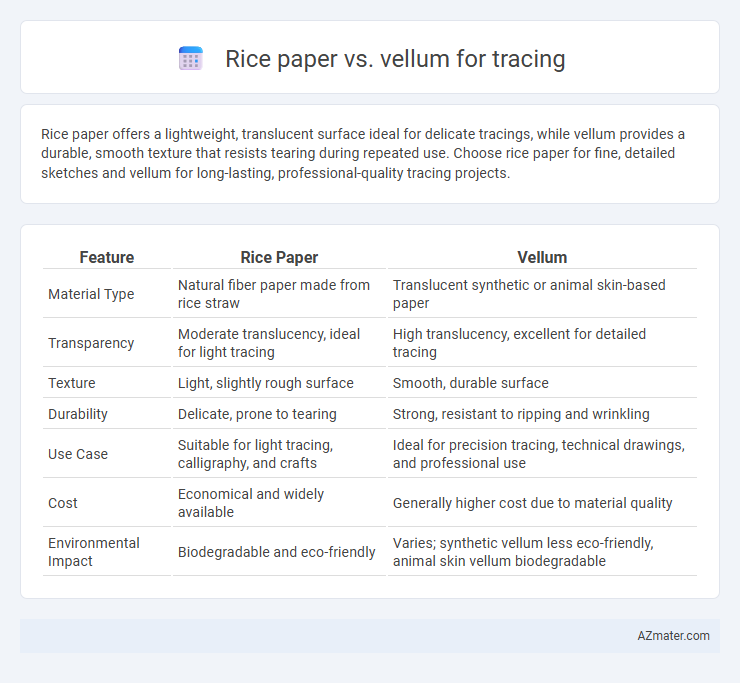Rice paper offers a lightweight, translucent surface ideal for delicate tracings, while vellum provides a durable, smooth texture that resists tearing during repeated use. Choose rice paper for fine, detailed sketches and vellum for long-lasting, professional-quality tracing projects.
Table of Comparison
| Feature | Rice Paper | Vellum |
|---|---|---|
| Material Type | Natural fiber paper made from rice straw | Translucent synthetic or animal skin-based paper |
| Transparency | Moderate translucency, ideal for light tracing | High translucency, excellent for detailed tracing |
| Texture | Light, slightly rough surface | Smooth, durable surface |
| Durability | Delicate, prone to tearing | Strong, resistant to ripping and wrinkling |
| Use Case | Suitable for light tracing, calligraphy, and crafts | Ideal for precision tracing, technical drawings, and professional use |
| Cost | Economical and widely available | Generally higher cost due to material quality |
| Environmental Impact | Biodegradable and eco-friendly | Varies; synthetic vellum less eco-friendly, animal skin vellum biodegradable |
Introduction: Rice Paper vs Vellum for Tracing
Rice paper offers a lightweight, semi-translucent surface ideal for delicate tracing projects, providing a natural texture that enhances pencil and ink visibility. Vellum, made from durable plastic or treated animal skins, delivers a smooth, stable tracing medium resistant to tearing and smudging, suitable for professional drafts and architectural designs. Both materials excel in traceability, but rice paper suits artistic, organic applications while vellum supports precision and longevity in technical work.
What is Rice Paper?
Rice paper, traditionally made from the pith of the Tetrapanax papyrifer plant or other fibers like bamboo and hemp, is a thin, translucent material ideal for tracing detailed artwork due to its smooth texture and lightweight nature. Unlike vellum, which is made from animal skin and offers greater durability and opacity, rice paper allows for delicate and precise line work, making it preferred in calligraphy and fine art tracing. Its absorbent surface also holds ink well, enhancing the clarity of traced images compared to vellum's more resistant finish.
What is Vellum?
Vellum is a high-quality, translucent material traditionally made from calfskin but now commonly produced using durable polyester or cellulose acetate fibers, prized for its smooth surface and excellent transparency ideal for precise tracing. Unlike rice paper, which is thin and delicate, vellum offers superior strength and resistance to tearing, making it suitable for repeated use in architectural or artistic drafting. The stable texture of vellum ensures crisp, clean lines and consistent performance for detailed tracing projects.
Key Differences Between Rice Paper and Vellum
Rice paper is thin, translucent, and highly absorbent, making it ideal for delicate brushwork and traditional Asian art tracing. Vellum, made from animal skin or synthetic materials, offers a sturdier, more durable surface with a smooth texture that resists tearing and warping during extended use. The key differences lie in rice paper's fragility and absorbency versus vellum's strength, smoothness, and longevity, influencing the choice based on project requirements and medium compatibility.
Texture and Transparency Comparison
Rice paper offers a lightweight, fibrous texture that enhances breathability and provides a natural grip, ideal for delicate tracing work. Vellum features a smooth, non-porous surface with higher transparency, allowing for precise line visibility and detailed tracing accuracy. The choice between rice paper and vellum depends on the desired tactile experience and the clarity needed for the tracing project.
Durability and Longevity
Rice paper offers a delicate texture ideal for light tracing but tends to be less durable and more prone to tearing or yellowing over time. Vellum, made from cellulose or animal skin, provides superior strength and longevity, resisting wear and degradation even with frequent handling. For projects requiring extended preservation and repeated use, vellum is the preferred choice due to its robust durability and archival quality.
Ease of Use for Tracing
Rice paper offers exceptional translucency and a smooth surface, making it ideal for precise and effortless tracing of intricate designs. Vellum, while more durable and thicker, can add slight resistance, requiring extra pressure when tracing fine details. Artists seeking seamless tracing with minimal hand fatigue often prefer rice paper for its lightweight and highly responsive texture.
Best Applications: When to Use Rice Paper
Rice paper is ideal for delicate art projects requiring thin, translucent materials such as calligraphy, watercolor layering, and intricate Asian-style paintings due to its lightweight texture and absorbency. It excels in applications demanding smooth ink flow and subtle color blending, making it suitable for tracing fine details without smudging. Rice paper's natural fibers provide flexibility and resilience beneficial for traditional brushwork and detailed tracing tasks where precision and texture are paramount.
Best Applications: When to Use Vellum
Vellum is ideal for detailed architectural and engineering drawings due to its smooth surface and durability, which allow for precise line work and layering without bleeding. Its translucent quality makes it perfect for overlays and color separations in graphic design and drafting. Vellum's resistance to aging and moisture also ensures long-term preservation of traced documents and blueprints.
Which is Better for Your Tracing Projects?
Rice paper offers a thin, translucent surface ideal for delicate tracing projects that require smooth ink flow and subtle texture, making it perfect for fine detail work. Vellum provides a sturdier, more durable surface with a smooth finish that resists tearing and warping, suitable for repeated tracing and mixed media applications. Choosing between rice paper and vellum depends on whether you prioritize gentle texture and transparency or durability and resilience for your tracing projects.

Infographic: Rice paper vs Vellum for Tracing
 azmater.com
azmater.com